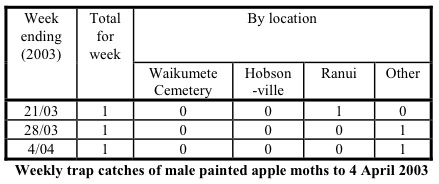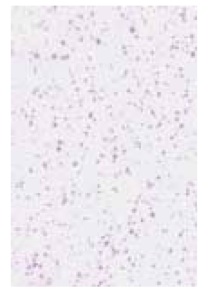PESTS AND DISEASES OF FORESTRY IN NEW ZEALAND
PAM eradication programme
Scion is the leading provider of forest-related knowledge in New Zealand
Formerly known as the Forest Research Institute, Scion has been a leader in research relating to forest health for over 50 years. The Rotorua-based Crown Research Institute continues to provide science that will protect all forests from damage caused by insect pests, pathogens and weeds. The information presented below arises from these research activities.
From Forest Health News 128, April 2003.
MAF has been managing an eradication programme for painted apple moth (Teia anartoides ) from the time of the initial detection in Glendene, Auckland, on 5 May 1999
(FHNews 85:1). Since October 2002, the campaign has focused on a core infestation zone covering 8,500 ha in west Auckland, and in December 2002 a further area of 1,500 ha comprising a population hotspot at Hobsonville was also included. The programme incorporates three complementary approaches: removal of host vegetation, ground and aerial spraying to kill larvae, and the use of sterilised insects to decrease the reproduction rate of the pest population.
The bulk of the aerial spraying is undertaken with a Fokker Friendship aircraft, while a small plane and a helicopter are used to target small or difficult areas. The product being applied is Foray 48B, a Btk-based formulation with over 30 years of safe international use (FHNews 116:1). Despite treatment, the infestation initially persisted at Waikumete Cemetery until the dense vegetation was removed and thinned over an area of 37 ha to allow effective spray penetration. Thousands of infertile male moths have been released weekly since 15 February 2003, after being treated with cobalt 60 using a sterilization technique applied to a range of imported food products such as herbs and spices. Sterile male moths have been released at sites where infestations persisted, such as at Waikumete Cemetery and Hobsonville. Sampling indicates that a high proportion of male moths is now infertile within the wild population.
 The effectiveness of the eradication campaign is being monitored by means of ground surveys together with a widely distributed grid of 1600 traps employing female moths to
The effectiveness of the eradication campaign is being monitored by means of ground surveys together with a widely distributed grid of 1600 traps employing female moths to
attract males. Progress is being made (see Table), and as a result the core treatment zone has been reduced to an area of ca. 6,600 ha. In January, February, and March, 30, 24, and 9 moths, respectively, were trapped, compared with 1300, 2300, and 996 moths for the same months in the previous year. For the first time during the campaign, no moths were caught in any trap, during the week to 11 April 2003. However, a sustained zero result, especially during the summer months, is needed to affirm the success of the project.
MAF is aware of the anxiety that aerial spraying has aroused among members of the public. Since its establishment in January 2002 some 10,000 people have telephoned the PAM Health Service with a health concern. Of these, some have merely required information over the telephone, but others were referred back to their own GP, while ca. 850 have undergone clinical assessment to determine whether the spray could affect them. Where a clinical assessment identifies that a householder should avoid the spray, an individualised ‘practical support plan’ (PSP) for that householder is developed. This may include spray-day warnings, a meal programme, motel accommodation, or in-home support. To date some 600 PSPs have been initiated.
MAF operates a comprehensive PAM communications programme. Television, radio and print advertising provide public advice and information on operational activities, the
health service, and restrictions on the movement of vegetation and household items. The operational headquarters, based in west Auckland, runs a public telephone service 24-hours a day, 7 days a week (0800 96 96 96). The project is also advised by several groups, which currently include a science and technical advisory group, whose purpose is to provide independent scientific advice, and a Community Liaison Group, which includes among its tasks the canvassing of views from within the community. A telephone survey in November 2002 found that 70% of 300 randomly selected adults within the PAM zone agreed or strongly agreed that the aerial operation was necessary, despite its inconvenience. In addition, there are potential Treaty of Waitangi issues associated with the eradication campaign. Local Maori have been consulted and a memorandum of understanding is being developed.
Rebecca Martel, MAF.
PAM programme spray monitoring
 In order to eradicate the painted apple moth, it is important to ensure that sufficient spray product deposits where it will most effectively reach the pest larvae. Spray monitoring in the Auckland area has been conducted by Forest Research using a technique developed by
In order to eradicate the painted apple moth, it is important to ensure that sufficient spray product deposits where it will most effectively reach the pest larvae. Spray monitoring in the Auckland area has been conducted by Forest Research using a technique developed by
John Ray (Forest Research), to disclose the deposits of Btk.
Sheets of plain white paper placed in the field during spraying are returned to the laboratory, immersed in a solution of ninhydrin, and baked until dry. The development of a purple colour indicates deposition of Btk spray droplets and enables the quantity to be determined.
Interpretation can be challenging, because other amino acid sources also react positively with ninhydrin, such as those present in fingerprints, bird droppings, or raindrops, and as Btk is soluble in water, deposits may redistribute in rain or dew if retrieval is delayed. To reduce these effects, field staff are asked to wear latex gloves and avoid coughing or sneezing.
Mike Haslett, Forest Research
This information is intended for general interest only. It is not intended to be a substitute for specific specialist advice on any matter and should not be relied on for that purpose. Scion will not be liable for any direct, indirect, incidental, special, consequential or exemplary damages, loss of profits, or any other intangible losses that result from using the information provided on this site.
(Scion is the trading name of the New Zealand Forest Research Institute Limited.)



